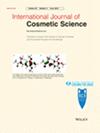Fermented tea leave extract against oxidative stress and ageing of skin in vitro and in vivo
Abstract
Objective
The objective is to develop a natural and stable anti-oxidative stress and anti-ageing ingredient. In this study, we evaluated the changes in white tea leaves fermented with Eurotium cristatum PLT-PE and Saccharomyces boulardii PLT-HZ and their efficacy against skin oxidative stress.
Methods
We employed untargeted metabolomics technology to analyse the differential metabolites between tea extract (TE) and fermented tea extract (FTE). In vitro, using H2O2-induced HaCaT cells, we evaluated cell vitality, ROS, and inflammatory factors (TNF-α, IL-1β, and IL-6). Additionally, we verified the effects on the extracellular matrix and nuclear DNA using fibroblasts or reconstructed skin models. We measured skin hydration, elasticity, wrinkle area, wrinkle area ratio, erythema area, and erythema area ratio in volunteers after using an emulsion containing 3% FTE for 28 and 56 days.
Results
Targeted metabolomics analysis of white tea leaves yielded more than 20 differential metabolites with antioxidant and anti-inflammatory activities, including amino acids, polypeptides, quercetin, and liquiritin post-fermentation. FTE, compared to TE, can significantly reduce reactive oxygen species (ROS) and protect against oxidative stress-induced skin damage in H2O2-induced HaCaT cells. FTE can inhibit H2O2-induced collagen degradation by suppressing the MAPK/c-Jun signalling pathway and can also mitigate the reactive oxygen species damage to nuclear DNA. Clinical studies showed that the volunteers' stratum corneum water content, skin elasticity, wrinkle area, wrinkle area ratio, erythema area, and erythema area ratio significantly improved from the baseline after 28 and 56 days of FTE use.
Conclusion
This study contributes to the growing body of literature supporting the protective effects against skin oxidative stress and ageing from fermented plant extracts. Moreover, our findings might inspire multidisciplinary efforts to investigate new fermentation techniques that could produce even more potent anti-ageing solutions.

 求助内容:
求助内容: 应助结果提醒方式:
应助结果提醒方式:


